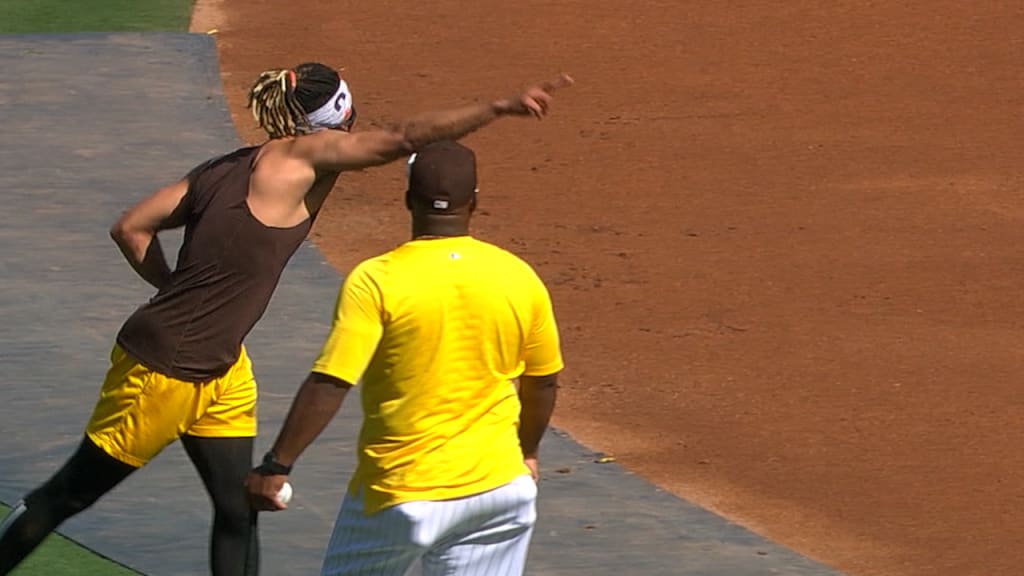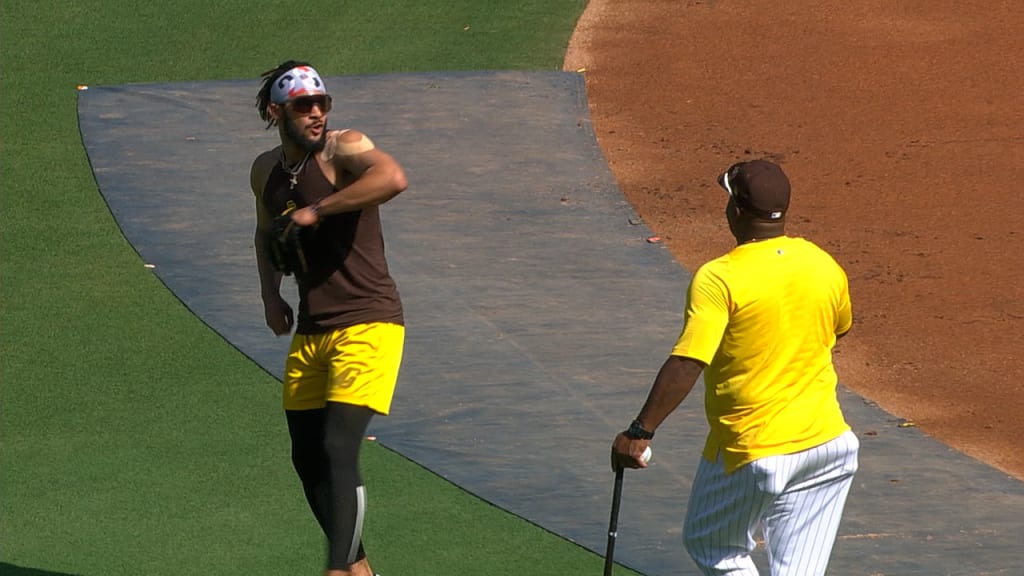What Tatis to outfield might mean for Padres
This browser does not support the video element.
As the Padres attempt to fend off the surging Reds to hold onto the second Wild Card spot and do their best to get back into the NL West race, they’re considering doing something all but unprecedented.
It's certainly sounding more and more like they will be moving shortstop Fernando Tatis Jr. to the outfield when he returns from a shoulder injury. If he moves to center field -- where he's been practicing -- and if it sticks for at least a few weeks, it’ll be the first time modern baseball has ever seen such a switch.
There are some caveats here, obviously, because it’s not that no one has ever moved from one spot to the other. Famously, Hall of Famer Robin Yount switched from shortstop to center field after 11 seasons due to -- wait for it -- a shoulder injury. Ian Desmond did it after six seasons as Washington’s shortstop, as a more recent example. Countless prospects have arrived in the pros as shortstops only to find themselves in the grass in the Majors. (Billy Hamilton and Juan Lagares, among many others.)
But Yount didn’t move in August; he did it in the winter leading up to the 1985 season. So did Desmond, upon joining Texas for 2016. So, supposedly, would have Tatis, had the Padres successfully traded for Francisco Lindor in the winter of 2019-20.
What’s happening here is that never, at least not in modern AL/NL history, have we ever seen this, a starting shortstop with zero professional outfield experience moving to become a regular outfielder in the middle of a season. We’ve seen second basemen do it; Jason Kipnis did so as recently as 2017. Trea Turner did in 2016, too, but after just seven games as a shortstop, and at least with the benefit of a handful of Triple-A games in center in the days leading up to it.
This browser does not support the video element.
But this, if it sticks even a little, would be something else. Let’s say Tatis gets into at least 25 of the remaining 48 San Diego games as a center fielder. He’d become just the 14th player to play 25 games at both shortstop and center field in the same season. That’s 14 players going back over 120 years, so right away, you know that’s rare.
25 games at shortstop and center in same season
2018 -- Chris Taylor
2016 -- Chris Owings
2014 -- Danny Santana
2001, ‘02 -- Melvin Mora
1998 -- José Hernández
1990 -- Eric Yelding
1987 -- Casey Candaele
1977, ‘80 -- Derrell Thomas
1977 -- Bob Bailor
1969 -- Mickey Stanley
1968 -- Cesar Tovar
1909 -- Freddy Parent
1906 -- Wid Conroy
It’s not a lot, and for a dozen of those players, they weren’t really “position switchers,” not in this way, because they were mainly prized for their versatility. Taylor is maybe the quintessential Swiss Army Knife of his era; this year alone, he’s appeared at every spot except for pitcher, catcher and first base. Owings perhaps comes the closest, having been pressed into service as the emergency Opening Day center fielder when A.J. Pollock fractured his elbow, though he’d never started even half of Arizona’s games as a shortstop before anyway.
Otherwise, with one exception, these were bench players, or role players who regularly played multiple spots. (The one exception is a fun one: In September 1968, Stanley, who was finishing up the first of three consecutive seasons in which he’d win a Gold Glove Award, was shifted to shortstop for the final week of the ‘68 season and the World Series. “I wasn’t real excited about it,” he later remembered. He started there 58 more times the next season, and still won the ‘69 Glove Glove in center.)
For what it’s worth, we looked in right field too, in case Tatis ends up there, and the results were similar. You can maybe look at Howard Johnson moving to the outfield for the final month of 1991, though he was more of a third baseman in the first place anyway; you could look at Cecil Travis’s 1936 adventures, though like Johnson, he’d mostly been a third baseman before that anyway.
The point is, this, if it happens, has never really happened before. So what do the Padres hope to gain from it?
1) Maybe it will keep him healthy.
This is the mostly (but not entirely) on-the-record reason. “The outfield experiment is designed to keep Tatis on the field once he does return. The infield presents more plays in which Tatis might dive with the left shoulder in a vulnerable position, plus possible collisions with baserunners,” wrote MLB.com’s Shaun O'Neill.
It’s difficult to quantify this, but it’s worth noting that Tatis’ shoulder troubles have hardly been limited to shortstop. When he hurt it the most recent time, on July 30, it was while sliding into third base trying to advance on a ground ball. Before that, in June, it was indeed on a dive at shortstop. When it happened in April, it was in the process of striking out. Before that, in March, it was also on a dive while fielding.
Besides, it’s not like the outfield is risk-free. We’re reminded of Matt Kemp injuring his shoulder running into the Coors Field wall in 2012, the start of a run of issues that sidetracked his career. On the other hand, a more recent Dodgers star followed a similar path as Tatis might be, when Cody Bellinger in 2019 injured his non-throwing shoulder on a dive at first base and was moved to the outfield.
“I do think, going forward, him being an outfielder makes the most sense,” manager Dave Roberts said at the time. “Being at first base, a potential dive, we’ll see how that goes as time goes by.”
“The reality is there’s risk in every position,” Tingler said. “We’ve got to weigh those things. … It’s not a clear-cut decision, by any means.”
It's not. That said, it's hard to deny that shortstops are more involved in the action. San Diego shortstops this year have had 449 chances, while center fielders have had just 262.
2) Maybe it will improve the San Diego defense.
Maybe, but again, maybe.
This gets tricky, because we don’t know that Tatis will be a good outfielder. No one doubts his raw athletic skills, of course, and outfield coach Wayne Kirby is certainly saying the right things.
"He's seeing the ball well off the bat," Kirby said. "His instincts are impeccable. He shouldn't have any problem. His speed will make up for the adjustment."
Perhaps so. Tatis is the fastest Padre, per Statcast numbers. The more confusing part is how to consider his performance at shortstop. In 2019, he was baseball’s third-weakest defensive shortstop, though it wasn’t hard to see why; it wasn’t that he couldn’t get to balls, it was that he was regularly making poor throws. In 2020, he cleaned those mistakes up and was baseball’s second-best defensive shortstop, which totally matched the eye test.
This year, he’s in the middle, a basically average 16th of 35 qualified shortstops. But even that requires further investigation, because his Outs Above Average marks, monthly, look like this:
April: -4 OAA
May: 0 OAA
June: +3 OAA
July: 0 OAA
So after a rough start, he’s been a mild plus for the last three months. Meanwhile, neither Jake Cronenworth or Ha-Seong Kim have made it clear they’re superior at the position in their brief opportunities, and Cronenworth has started the last six games at the position, including Tuesday night.
Meanwhile, in the outfield, 2020 Gold Glover Trent Grisham is one of baseball’s better center fielders. Regardless of whether Grisham or Tatis might spot in right, they’d take over from Wil Myers, who has been solid enough the last two seasons. San Diego also acquired Jake Marisnick at the Deadline, long regarded as one of baseball’s best defensive outfielders.
So does this improve the defense? Only if you think Kim or Cronenworth are meaningfully better than Tatis at shortstop, and that assumes Tatis is immediately capable on the grass. Kim, however, hasn’t hit at all this year (.215/.275/.364), though he’s off to a good start in August.
This browser does not support the video element.
3) It reduces playing time for Myers or Tommy Pham.
Maybe this would push Myers to the bench. Maybe, also, it would push him to left, and push Pham to the bench. Myers was fantastic in 2020 while Pham struggled; this year, they’ve essentially performed identically, slightly above-average. Given the choice of the two of them plus Grisham plus Tatis, you’d easily pick one to bench each night. Sensible enough, but hold that thought, because ...
4) It avoids the Eric Hosmer question.
... there’s this aspect of it, too. Once the Padres traded for second baseman Adam Frazier, it was clear there would be too many infielders for not enough spots, and there were plenty of rumors flying that San Diego was trying to move the underperforming Hosmer and allow Cronenworth to play more at first base.
That didn’t happen, obviously. Despite a good showing in 2020 (where he played only 38 games), Hosmer has hit only .265/.323/.418 in his career for the Padres, a 102 OPS+, and -0.5 WAR (per FanGraphs). Since he arrived in 2018, San Diego has had the fourth-weakest first base production, and that’s not exactly what they expected from their eight-year, $144 million investment.
If you were to look at the 2021 rest of season projections (excluding the catchers), you’ll see there’s six Padres hitters projected to be better than Hosmer. Frazier is seen as similar, but he offers considerably more defensive versatility. Same thing for Kim.
If Tatis is in the infield, then Hosmer is at best the fourth-best infield option, and potentially as low as sixth if you value the defensive versatility of Kim and Cronenworth more. If Tatis is not in the infield, a lot more options open up. Uncomfortable conversations need not be had.
Ultimately, there’s still some time before any of this happens. It may never actually happen. But if it does, there’s a lot of moving parts here. It may or may not improve the defense. It probably wouldn’t improve the offense, not if it gets Hosmer and/or Kim more guaranteed plate appearances. And it may or may not keep Tatis healthier, though of course if it does, that’s worth more than any other consideration.
The only thing we can say for sure about all of this is that if it happens, watch closely. We’ve never really seen anything like this happening in-season before.

